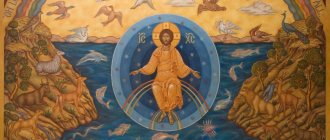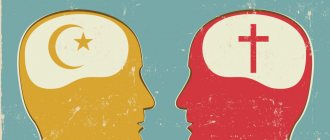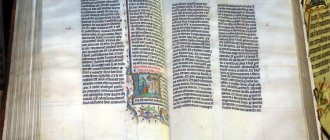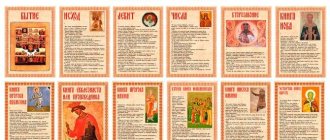Holy Orthodox books are a kind of compass for the spiritual advancement of Christians in knowledge of the will of God. The Bible is the Holy Scripture given by the Creator to humanity. The historical merits of the texts of the Holy Scriptures lie in the fact that they were written by specific people who lived at a certain time, according to the knowledge bestowed by the Almighty Himself.
Great prophets, who had the gift of communicating with God, wrote down messages to humanity to show concrete examples of the reality and power of the Lord.
Apostle John the Theologian
What the Bible Includes
The Bible includes 66 books:
- 39 messages of the Old Testament;
- 27 books of the New Testament.
These books are the basis of the biblical canon. Holy books in Orthodoxy are inspired by God, for they were written under the guidance of the Holy Spirit. The Bible is a must-read and study for every Christian.
In the Bible, Holy Scripture, the creator said “Do not be afraid!” 365 times. and the same number of “Rejoice!” The great promise from the Creator is given to thank the Creator every day, constantly being in joy.
Only by understanding the texts of the Holy Scriptures and finding confirmation in the stories of the saints can one learn what and how to rejoice and what to thank God for. Without knowing the origins of the creation of the world, it is impossible to fully believe in the reality of the events taking place in the New Testament.
About the Bible:
- 15 Interesting Facts About the Bible
- Who is Judas Iscariot in the Bible
- Epistle to the Galatians by St. Paul the Apostle
LiveInternetLiveInternet
Quote from The Lone Ranger
Read in full In your quotation book or community!
SACRED BOOKS OF THE PEOPLES OF THE WORLD
Even in prehistoric times, the priests of ancient peoples wrote down their knowledge in order to perpetuate it and pass it on to descendants, therefore, in the most famous historical museums in the world, each of us can see stone and wooden tablets and ancient papyrus scrolls, which describe the rituals of worshiping the ancient gods and recorded information about one or another aspect of society at that time. Over time, the tradition of recording all the most important events and information has not disappeared, and thanks to it we can learn quite a lot about the life and customs of ancient peoples.
All the sacred books of the world's religions also owe their existence to the tradition of recording all the most important things. Each of the three world religions has its own sacred book, which records all the dogmas of faith, cults and traditions, indicates the rules and norms that are mandatory or recommended for all adherents of the religion, and also describes historical information, myths and biographies of the founders of the religion and some other people, who left an important mark in the history of the formation of beliefs.
THE BIBLE IS THE HOLY BOOK OF CHRISTIANS
The Bible (from the Greek βιβλία - books) or Holy Scripture is a collection of Books compiled by the inspiration of the Holy Spirit (i.e. God) through chosen people sanctified by God: prophets and apostles. St. Church.
The Bible consists of two main parts - the Old Testament and the New Testament , and according to belief, the first part was written before the first coming of Christ, and the second after his birth. The number of books of Christian Bibles ranges from the Protestant canon (66 books) to the "broad" canon of the Ethiopian Orthodox Church (81 books).
The Bible is a religious book. The main theme of the Bible is the salvation of mankind through the Messiah, the incarnate Son of God Jesus Christ. The Old Testament speaks of salvation in the form of types and prophecies about the Messiah and the Kingdom of God. The New Testament sets forth the very realization of our salvation through the incarnation, life and teaching of the God-man, sealed by His death on the cross and resurrection.
TANAKH - THE HOLY BOOK OF THE JEWS
The Tanakh is the Old Testament of the Bible, which followers of Judaism, in turn, divide into three parts:
1. Torah - the first five books (Genesis, Exodus, Leviticus, Numbers and Deuteronomy)
2. Neviim - eight books written by the prophets, consisting mainly of a description of the history of the Jewish people from the moment they came to the “promised land” until the Jewish people were captured by the Babylonian kingdom
3. Ketuvim - the remaining 11 books of the Old Testament, which are also called “the writings of the saints.”
It should be noted that there are certain differences between the Tanakh and the Old Testament of the Christian Bible - adherents of Judaism consider some of those books of the Old Testament that Christians recognize as canonical to be apocrypha. Also, Jews are sure that there are 4 levels (or layers) of interpretation of the Tanakh, and if the first three layers of understanding of the Holy Scriptures (literal, figurative and logical understanding) are available to every person, but the Kabbalistic understanding comes only to the chosen ones.
THE QURAN IS THE HOLY BOOK OF ISLAM
The Koran , the holy book of Muslims, consists of the revelations of the prophet Muhammad, which through him Allah revealed to believers. The Qur'an was rewritten several times, and the only canonical version is believed to have been approved in the seventh century AD by a panel of surviving companions of Mahomed. However, now there are 7 versions of reading the Koran, each of which was formed by one or another Muslim school of the initial period of Islamic history.
The Muslim holy book consists of 114 suras (chapters), and each sura, in turn, includes from 3 to 286 ayats (verses). All suras are divided into Meccan suras , which record the revelations given to the prophet Magomed by the angel Gabriel before moving to Medina, and Medina - suras recorded from the words of the prophet after he arrived in Medina. In addition to the basic dogmas of religion, prophecies and instructions to believers, the Koran contains the biographies of the prophets whom God sent to earth.
After reading this holy book, we can conclude that Muslims, Christians, and Jews believe in the same prophets - the Koran mentions Noah, Solomon, Moses, Jesus and other apostles whose names are in the Bible. However, Muslims are confident that it is the revelations of the last prophet Magomed that most comprehensively convey the will of God to people, therefore believers need to live according to his covenants.
TRIPITAKA - THE SACRED BOOK OF THE BUDDHISTS
The history of the creation of Tripitaka began in the seventh century BC, after the achievement of parinirvana by Buddha Shakyamuni. Initially, the sacred knowledge of Buddhists was transmitted only orally, but at the Fourth Buddhist Council it was decided to perpetuate the teachings of the Buddha, and the Tripitaka was written down on papyri made from palm leaves. Since this holy book was written in the Pali language, it is also known throughout the world as the Pali Canon.
This holy book consists of three main parts - “three baskets”:
1. Vinaya-Pitaka - a basket of rules of conduct; this part of the Pali Canon outlines the rules and norms of behavior for nuns and monks who have renounced worldly life and live in Buddhist monasteries
2. Suttanta Pitaka - basket of instructions; This part of the Tripitaka records the instructions of the Buddha, which both young monks and lay people should follow. It is in the Suttanta Pitaka that the key dogmas of the Buddhist religion are described
3. Abhidhamma Pitaka - basket of doctrines; it does not include the sayings of the Buddha himself, but the works of his students and followers devoted to the art of meditation. This part of the Pali canon is dominated by texts devoted to psychology, theories of thought and knowledge and cognition, ethics, and philosophy.
VEDAS - THE SACRED BOOK OF HINDUISM
The Vedas can undoubtedly be called one of the oldest sacred books of the world's religions, since its first part was written down in the 16th century BC. The sacred texts of Hinduism were originally written in Sanskrit, and most of the knowledge presented in this book is Samhitas (collections of mantras for religious rituals and prayers) and commentaries and explanations to them. According to Hindu beliefs, the Vedas were not compiled by humans, but were revealed to humanity by the gods through holy sages. The holy book Veda consists of four Vedas:
1. Rig Veda - Veda of hymns; it contains mantras that are pronounced in prayers by the main clergy. According to researchers, the Rig Veda, both in linguistics and in content, has much in common with the sacred book of the ancient Iranians - the Avesta
2. Yajur Veda - Veda of sacrificial formulas; This part of the holy book of Hinduism contains mantras that must be recited during sacrificial rituals, as well as mantras to be read during almost all Vedic rituals
3. Sama Veda - the Veda of melodies; The Samaveda contains mantras that clergy chant during worship, and each mantra must be chanted in a strictly defined rhythm
4. Atharva Veda - the Veda of spells; This part of the holy book describes not only rites and rituals, but also pays attention to the daily life of the ancient Hindus. This Veda records some medical and military knowledge, in particular, it outlines the causes and methods of treating a number of diseases, as well as methods for making poisons, poisoned arrows, smoke screens, etc.
AVESTA – THE SACRED BOOK OF ZOROASTRIANism
The main idea of this religion is the dependence of the world order on the struggle between good and evil, light and darkness, life and death. According to the religion of Zoroastrianism, a person in this struggle is not a toy in the hands of higher powers, but a person who has freedom of choice, capable of influencing the progress of world justice through his activity. The Avesta was written in one of the ancient Iranian languages; scientists have not determined exactly which tribes or peoples spoke this language, and therefore call that language after the name of the monument - “Avestic”. The Avesta consists of several parts. The most ancient of them is “Gats” - a collection of prayers. The author of these texts is considered to be the founder of the ancient Iranian religion, Zoroaster. In all the teachings of the gats, we are talking about life, everyday life, and norms of behavior.
ADI GRANTHAH - THE SACRED SCRIPTURE OF THE SIKHS
The Adi Granth is the main sacred text of the Sikhs, written during the period of the Sikh Gurus from 1469 to 1708. It is a collection of religious hymns that describe the qualities of God and talk about the need to meditate on the names of God. This religion emphasizes the unity of God as the supreme being. To define the Almighty, names borrowed from both Hindus and Muslims are used. God is impersonal (Nirgun) and personal (Sargun). The impersonal aspect of the Divine is formless and inaccessible to humans. When He is revealed through His Creation, He becomes relational and personal.
LUN YU - THE SACRED BOOK OF CONFUCIANITY
The title of the book means “Conversations and Judgments.” It was written down by followers of Confucius and is a record of his conversations with his disciples. The book outlines the concept of a perfect person who lives in harmony with Heaven, and also provides a program aimed at improving a person in order to understand the basic Cosmic Laws.
As you can see, every religion has its own holy book. It allows believers to always have the opportunity to turn to divine wisdom in order to improve their own lives. The holy book is an indispensable component of religion and helps to preserve its foundations unchanged.
Why should an Orthodox believer read the Old Testament?
The Old Testament begins with the basics, a description of events from the creation of the world to 400 before the coming of Jesus Christ to earth. The Pentateuch (first 5 books) or Torah in Hebrew was written by the prophet Moses.
Prophet Moses
The first book of Genesis describes a long period from the first man, the global flood, God's creation of His Jewish people, the birth of Isaac, Jacob, the entry into Egypt and the exit from it after 400 years. Some people wonder how humanity learned about Adam if there was a global flood. The answer is found in the Holy Scripture itself, if you read it carefully, making sure to pray to the Almighty.
The Jews have preserved a good rule, coming from the first people, to know their ancestors up to the 14th generation. Noah's grandfather was still alive during Adam's last days. Of course, the little boy heard the story of the creation of the earth and the first people more than once, and then Noah passed it on to his sons. This is how you can historically prove the righteousness of every message conveyed by God to humanity through the prophets.
For 1500 years, from Abraham, the first Jew on earth, to Malachi, through life circumstances, God appeared to kings and shepherds, prophets and priests, warriors and judges.
An amazing fact is that the biblical sacred texts written at different times by different people are consistent with each other and seem to be a continuation and addition of one another.
Exodus shows God's care for His people, who wandered in the desert for 40 years because of murmuring, but at the same time the Creator did not leave the Jews without His guidance for a moment.
The Jews moved through the desert under the guidance of a pillar, which was dusty during the day and fiery at night. It was the Holy Spirit who led God's people out of slavery. In the desert, on Mount Sinai, God gave his 10 commandments, which became the basis of all Christianity, law and guide.
Ten Commandments (tablets)
Based on historical facts, it is easy to trace the prototype of Jesus Christ, for example, at the moment when the people were attacked by snakes, the one who kept his gaze on the staff of Moses was saved, and Orthodox people will never perish if they constantly look at Christ.
The laws of blessing and cursing are recorded in Deuteronomy. A faithful God always does what he promises. (Deuteronomy 28)
The books of the Prophets describe the development of the Jewish people, their reign, and prophecies about the birth of the Messiah run through them as a red thread. Reading the book of the prophet Isaiah, one cannot shake the feeling of unreality, because he lived almost 600 years before the coming and death of Jesus, and he described in detail the birth of Christ, the killing of infants, and the crucifixion.
In chapter 42, through Isaiah, God makes a promise to always be there for His faithful children.
The 12 books of the minor prophets show the real communication of mortal people, faithful to God with their whole lives, with the Creator. They knew how to hear the Creator and were obedient in fulfilling His commands. Through faithful prophets, God spoke to the world.
King David was faithful to the Lord, for which he was awarded the title of a man after God's heart. Psalms, recorded from the songs of David and the prophets, formed the basis of many prayers. Every Orthodox Christian knows that in times of trial, Psalms 22, 50, 90 help to overcome fear and feel the Protection of God.
King David
Solomon was not David's eldest son, but it was him who the Creator chose to be king. Because Solomon did not ask God for wealth and glory, but only wisdom, the Creator granted him the richest reign on earth.
Psalms of David:
- Psalm of David 22
- Psalm of David 50
- Psalm of David 90
Ask God for wisdom so that your earthly life will be filled with completeness:
- God's knowledge;
- fear of the Savior;
- family happiness;
- children's laughter;
- wealth;
- health.
The books of Daniel, Malachi, Ezra carry encrypted messages to humanity until the end of earthly existence; they echo the Revelation of John from the New Testament. After Malachi there is no record of God's messages.
For 400 years before the birth of Jesus, the Creator was silent, observing the observance of His laws by the chosen people.
Humanity at that time represented many peoples, they had their own gods, worship, rituals, which in the eyes of the Creator was an abomination.
Seeing the hardened hearts of the world's population, who try to earn forgiveness of sins by killing animals as sacrifices, God sends His Son, Jesus Christ, to the people. The Savior became the final sacrifice, for everyone who believes in Him will be saved. (John 10:9)
Sacred texts of Judaism
Tanakh (Jewish Bible)
Consists of the Law (Torah), Prophets (Neviim) and Scriptures (Ketuvim); her books were written over a period spanning more than thirteen centuries of Jewish history, from the time of Moses to the last few centuries BC.
1. Torah (Law) The Pentateuch, the so-called Mosaic Law, is the first five books of the canonical Jewish and Christian Bible: Genesis, Exodus, Leviticus, Numbers and Deuteronomy.
2. Nevi'im (Prophets) Includes the books of Joshua, Judges, Samuel, Kings, which tell the history of Israel under the leadership of the prophets, and the books of the prophets Isaiah, Jeremiah, Ezekiel, Amos, Hosea, Micah, Habakkuk, Jonah, Haggai, Zechariah, Malachi and others
3. Ketuvim (Scriptures) Includes the book of Psalms, which are prayers and hymns; Proverbs, the books of Ecclesiastes and Job, containing sayings, discourses on wisdom and reflections on human existence; The Lamentations of Jeremiah, telling of the destruction of the Jerusalem Temple; the love poem Song of Songs, which has long been interpreted as a description of the mystical relationship between God and Israel or between God and man; the book of the prophet Daniel, which tells about faith in times of persecution.
Talmud
In addition to the Tanaka, there was a tradition of the Oral Torah, which existed among the rabbis in the first centuries of our era and was codified as the Talmud.
It consists of two main parts - the Mishnah and the Gemara - and carries enormous authority for the observant Jew.
The Talmud can also be regarded as the development of the tradition of commenting on the text of the Bible for its correct understanding. Although most of the Talmud is devoted to the interpretation and codification of the Law, there are passages in it that have the character of universal spiritual and ethical wisdom. The best known in the Talmud is a small treatise called Abot, or Sayings of the Fathers, relating to the Mishnah. The books of Midrash (rabbinic commentaries on scripture) are rich in moral and spiritual teachings and stories.
Rabbinic texts
Other rabbinical texts of the same period also enjoy great authority among devout Jews: Sifra , which includes the Numbers of Sifra and Deuteronomy Sifra, Tanchuma, Pesikta Rabbati and Pesikta Kahana, Tosefta .
Kabbalah
In addition to them, the books of prayers established by the Law attract attention in the Jewish tradition. Mystical treatise. The Zohar and a number of other writings form the Kabbalah, a mystical tradition that has canonical significance for many Jews.
Theological treatises
A number of theological treatises are also of great importance, among which are about Moses Maimonides (1135-1204) and “Shulchan Aruch” by Joseph Karo (16th century).
The New Testament - A Guide to Living with Christ
With the birth of the Savior, a new era in the history of mankind begins. The New Testament describes the main stages of Christ's stay on earth:
- conception;
- birth;
- life;
- miracles;
- death;
- resurrection;
- Ascension.
Jesus Christ is the heart of the entire Bible. There is no other way to gain eternal life except by faith in the Savior, for Jesus Himself called Himself the Way, the Truth and the Life (John 14).
Each of the twelve apostles left a message to the world. Only four Gospels included in the New Testament are recognized as inspired and canonical.
Twelve disciples of Jesus Christ
The New Testament begins with the Gospels, the Good News conveyed through ordinary people who later became apostles. The Sermon on the Mount, known to all Christians, teaches believers how to become blessed in order to acquire the kingdom of God already on earth.
Only John was among the disciples who were constantly near the Teacher. Luke at one time healed people; all the information conveyed to him was collected during the time of Paul, after the crucifixion of the Savior. This message reflects the researcher's approach to historical events. Matthew was chosen as one of the 12 apostles instead of the traitor Judas Iscariot.
Important! Epistles that are not included in the New Testament due to doubts about their authenticity are called apocryphal. The most famous of them are the Gospels of Judas, Thomas, Mary Magdalene and others.
In the “Acts of the Holy Apostles,” transmitted by the Apostle Paul, who never saw Jesus the man, but who was given the grace to hear and see the bright Light of the Son of God, the life of Christians after the resurrection of Christ is described. The teaching books of the New Testament contain the messages of the apostles to specific people and entire churches.
By studying the Word of God, transmitted by His disciples, Orthodox people see before themselves an example to follow, to be transformed into the image of the Savior. Paul's first letter to the Corinthians contains a hymn of love (1 Cor. 13:4-8), reading each point of which you truly begin to understand what God's love is.
In Galatians 5:19-23, the Apostle Paul offers a test by which every Orthodox believer can determine whether he is walking according to the flesh or according to the spirit.
The Apostle James showed the power of the word and the unbridled tongue through which both blessing and curse flow.
The New Testament ends with the book of Revelations of the Apostle John, the only one of all twelve disciples of Jesus who died a natural death. At the age of 80, for his worship of Christ, John was created on the island of Patmos for hard work, from where he was transferred to heaven to receive Revelation for humanity.
Attention! Revelation is the most difficult book to understand, its messages are revealed to selected Christians who have a personal relationship with the Holy Trinity.
Revelation of Saint John the Theologian
Christianity: history and fundamentals of doctrine
- Stages of the emergence and development of Christianity. Socio-historical conditions, religious and philosophical origins.
- The Bible as a source of Christian doctrine. Holy Scripture: books of the Old and New Testaments, their structure and main content.
- Dogmas and sacraments of Christianity. The concept of Sacred Tradition. Activities of Ecumenical Councils.
- Ethics of Christianity. Decalogue of the Old Testament and the Beatitudes of the New Testament. Sermon on the Mount of Jesus Christ.
- Stages of the emergence and development of Christianity. Socio-historical conditions, religious and philosophical origins.
1) Christianity is the second religion in terms of origin and the most numerous in terms of the number of adherents.
Christianity arose in the 1st century. AD on the territory of the Roman Empire as a result of the interaction of the monotheistic tradition of Judaism with the religious beliefs of the ancient Greeks and Romans, as well as the peoples of Western Asia. Christianity is not a single religion. It breaks down into a number of independent directions: Catholicism, Orthodoxy, Protestantism. The founder of Christianity is Jesus Christ. Christianity and Judaism. The setting of all gospel stories is Palestine. By the time of the emergence of Christianity, traditional Judaism was experiencing a crisis associated with the loss of independence, Roman oppression, contradictions between the population of Judea and the Jews of the Diaspora, and the widespread penetration of Greco-Roman traditions, customs, and beliefs into the life and culture.
There were three most influential movements in Judaism of that era:
1) Sadducees
who tried to adapt Judaism to Greco-Roman culture, to make it more rational;
2) Pharisees
who advocated literal, albeit ostentatious, adherence to the commandments and rituals of the Old Testament;
3) Essenes
who broke with traditional Judaism, lived in secluded commune communities, preached asceticism and the imminent coming of the Messiah.
The emergence of Christianity is associated with the latter trend, as evidenced by archaeological finds in the caves of Qumran near the Dead Sea. The final formation of Christianity as a religion distinct from Judaism occurred among the Jewish diaspora. From Judaism, Christianity borrowed monotheism, the cult of Yahweh, identified with God the Father, part of the Holy Scriptures - the Old Testament, many dogmas and rituals. It took shape as an independent religion only in the 2nd century.
The formation of Christianity. The following reasons contributed to the spread of Christianity:
1) its democracy
, universalism of moral principles, leveling of class and social differences. Everyone was equal before God.
2) The idea of equality before God
was based on the ideas
of sinfulness and salvation
.
The sinfulness of man and the world was explained by the Fall of Adam. Christ, God the Son, was crucified for the atonement of human sins. The idea of salvation
was realized through the idea of redemption.
The righteous person who believed in Christ was promised eternal bliss - either after the imminent, according to the first Christians, end of the world and the Last Judgment
, at which everyone “will be rewarded according to his deeds,” or in the afterlife.
3) The democracy of early Christianity was reflected in the structure of communities where everyone was accepted, in the principles of brotherhood and mutual assistance affirmed by the first Christians, in the community of property, in the distribution of alms, in joint “meals of love” ( agapas)
), in which rich and poor participated equally. The Gospel myth about Christ itself pointed to the appeal of the new religion to the lower strata of society: only slaves were executed by crucifixion in Rome.
As the number of communities increases, the number of wealthy people among converts grows, meals become a thing of the past. Democracy is giving way to hierarchy and centralization.
Initially, Christian communities did not have a church clergy - permanent ministers of worship and property managers. From the point of view of the development of church organization in the history of Christianity, three stages can be distinguished:
1) democratic period (I-II centuries), when communities were led by prophets, apostles, i.e. charismatics - persons who were credited with possessing a special grace received from the Holy Spirit - “charisma”;
2) episcopal period , when the clergy was formed (late II-IV centuries): bishops (Greek, “overseers”), who were in charge of money and property, deacons (Greek, “ministers”), who led the cult side of the life of the community, presbyters (Greek. "elders"), authorities in matters of religion;
3) the formation of an integral church hierarchy (IV-VIII centuries), the emergence of metropolitans - leaders of individual churches consisting of several episcopates, patriarchs - heads of church associations that extended their power to several regions, etc.
- The Bible as a source of Christian doctrine. Holy Scripture: books of the Old and New Testaments, their structure and main content.
The Holy Scripture of Christians is the Bible (Greek books), consisting of the Old Testament and the New Testament. According to Christian teaching, Holy Scripture is “inspired by God,” i.e. received as a result of divine revelation, and its texts are canonical (Greek law), binding on believers.
The Old Testament of Christians is a translation of the Jewish Tanakh. For Christians, it is inseparable from the later New Testament, which is categorically rejected by Judaism. Unlike Judaists, who read the Tanakh in the original, in Hebrew, Orthodox and Catholics revere the Old Testament, which dates back to the text of the Septuagint (Greek translation of 70 interpreters) - the translation of the Tanakh from Hebrew into Ancient Greek, carried out in the 3rd-2nd centuries. BC. This translation contains not only the canonical Jewish Tanakh (39 books), but also 11 non-canonical books created by Diaspora Jews in a later era, as well as Greek additions to the canonical texts. Among Orthodox and Catholics, the number of revered books and additions to them differs slightly. Protestants consider the exact translation of the Old Testament from the Hebrew language to be canonical.
The New Testament, consisting of 27 books, is dedicated to the activities of Christ and his closest associates - the apostles (Greek messenger), and therefore bears the name New - in contrast to the Old, concluded by God only with the Jews. The apostles and their disciples are credited with the authorship of all the books of the New Testament. The structure of the New Testament can be divided into three parts:
| Gospels | From Matthew, from Mark, from Luke, from John | A description of the birth, preaching activity, death and resurrection of Christ based on oral traditions | Mid-1st end of 2nd century. |
| Epistles of the Apostles | 2 Epistles of James, 2 Epistles of Peter, 3 Epistles of John, Epistle of Jude, 14 Epistles of Paul | Messages exchanged by leaders of Christian communities in various cities for the purpose of preaching and developing common dogma | End of the 1st – beginning of the 2nd century. |
| Other books | Acts of the Apostles | A late attempt to create a history of the preaching activities of the apostles | II century |
| Revelation of John the Evangelist (Apocalypse) | Biblical text containing eschatological prophecies | 68-69 |
There are obvious contradictions between the canonical texts of the Bible due to the fact that they were created at different times by representatives of different movements in early Christianity. It is generally accepted that the oldest of the books of the New Testament is the Apocalypse; The oldest of the Gospels is the Gospel of Mark.
In addition to canonical texts, Christian apocrypha (Greek: hidden) have also been preserved - works that, for one reason or another, were rejected by the official church and were not included in the canon. As a result of archaeological searches, the Gospels of Peter, Philip, Thomas, the Gospel of Truth, the Apocalypse of Peter and other apocrypha were discovered.
- Dogmas and sacraments of Christianity. The concept of Sacred Tradition. Activities of Ecumenical Councils.
Sacred Tradition (legend) is one of the sources of doctrine and church law in Orthodoxy and Catholicism, along with the Holy Scriptures. By Sacred Tradition we mean those information and canonical provisions professed by historical churches that are not directly contained in the Old or New Testament; includes canons, liturgical texts authorized by churches, the works of the Church Fathers, lives of saints, as well as church customs.
Canon (from the Greek “rule, norm”) is an ecclesiastical establishment of the apostles, Ecumenical Councils, some local councils and the Fathers of the Church concerning church structure and rules.
Christian dogmatics was formulated and generalized in the 4th-8th centuries. at the Ecumenical Councils -
congresses of representatives of Christian churches around the world, in the process of intense struggle between different directions in Christianity, theological schools, with the active participation of the imperial authorities, interested in church, and therefore state, unity.
The First Council of Nicaea made the divine origin of Jesus Christ (the first part of the Creed) a dogma. The First Council of Constantinople formulated the second part of the Creed, recognizing the divinity of the Holy Spirit. The Council of Ephesus made a dogma of the definition of Jesus Christ as the incarnate Logos - the Word of God, and also legalized the veneration of the Virgin Mary as the Mother of God. At the Council of Chalcedon, the church made a dogma of the understanding of Jesus Christ as true God and true man in one person. The dogma of the Trinity and Jesus Christ as the “consubstantial” Son of the Father was finally formalized at the Second Council of Constantinople.
The Third Council of Constantinople, in order to combat heresies, recognized the human will of Christ, and the Second Council of Nicea, condemning the iconoclasts who denied the veneration of icons as heresy, made the cult of icons mandatory.
The result of the activities of the Ecumenical Councils is the Creed, which in concentrated form contains all Christian dogma:
1. I believe in One God the Father, Almighty, Creator of heaven and earth.
2. I believe in the One Lord Jesus Christ, the Son of God, the Only Begotten, from the Father before all ages, Light from Light, True God, begotten of True God, not created, Consubstantial with the Father.
3. I believe in the mystery of the incarnation and atonement of Jesus Christ.
4. I believe in the suffering of Jesus Christ, crucified for us under Pontius Pilate.
5. I believe in the resurrection of Jesus Christ on the third day according to Scripture.
6. I believe in the ascension of Jesus Christ into heaven.
7. I believe in the Second Coming and the Last Judgment.
8. I believe in the Holy Spirit, the Lord, the Life-Giving One, who proceeds from the Father.
9. I believe in the One, Holy, Catholic and Apostolic Church.
10. I confess baptism and remission of sins.
11. I look forward to the coming resurrection of the dead.
12. I look forward to eternal life.
- Ethics of Christianity. Decalogue of the Old Testament and the Beatitudes of the New Testament. Sermon on the Mount of Jesus Christ.
Christian ethics, or the moral teaching of Christianity, determines the moral guidelines of human behavior. The source of Christian ethics is, first of all, the Decalogue of the Old Testament, the life of Christ, the commandments of the Sermon on the Mount, the life and preaching of His disciples, apostles, Fathers of the Church, as well as examples of moral life revealed in the life of the modern Church.
Ten Commandments ( Decalogue
, or
the Law of God
) - prescriptions, ten basic laws, which, according to the Pentateuch (the first five books of the canonical Jewish and Christian Bible: Genesis, Exodus, Leviticus, Numbers and Deuteronomy), were given by God himself to Moses, in the presence of the children of Israel, on Mt. Sinai on the fiftieth day after the Exodus from Egypt. The Ten Commandments are contained in the Pentateuch in two slightly different versions (Exodus and Deuteronomy).
The setting in which God gave Moses and the children of Israel the Ten Commandments is described in the Bible. Sinai stood on fire, shrouded in thick smoke, the earth trembled, thunder roared, lightning flashed, and, in the noise of the raging elements, covering it, the voice of God was heard, pronouncing the commandments. Then the Lord himself inscribed the “Ten Words” on two stone tablets (slabs of stone), the “Tablets of Testimony,” and gave them to Moses. When Moses, after a forty-day stay on the mountain, came down with the tablets in his hands and saw that the people, having forgotten about God, were dancing around the Golden Calf (the Golden Calf is an idol that appears several times on the pages of the Old Testament as an object of cult for those who apostatized Israel from God), Then he fell into such terrible anger at the sight of the unbridled feast that he smashed the tablets with the commandments of God against the rock. After the ensuing repentance of the entire people, God ordered Moses to hew two new stone tablets and bring them to Him for re-writing of the Ten Commandments (in Deuteronomy).
The Latin phrase Biblia Sacra ("sacred books") first arose in the Middle Ages. In English - one of the first (if not the very first) - the name "The Holy Bible" appeared in 1611 on the cover of the "authorized version" known as the King James Bible. The word “holy” or “sacred” has several meanings, and below we will consider whether they all refer to the Word of God.
When God spoke to Moses at the burning bush, He told him to take off his sandals because he was standing on “holy ground”—ground sanctified by the Divine presence. Since God is holy, the words He speaks are also holy. In the same way, the words that God gave to Moses on Mount Sinai are as sacred as all the words that God gave to mankind in the Bible. Because God is perfect, his words are perfect (Psalm 18:8). God is righteous and pure, and so is His Word (Psalm 18:9).
The Bible is also sacred because it was written by men under the guidance and influence of the Holy Spirit. “All Scripture is God-breathed and useful: it helps to teach, reprove, correct, instruct how to live an honest life, so that the servant of God is fully equipped and equipped for every good work” (2 Timothy 3:16-17, hereinafter - Russian translation Bible Society). The Greek word translated “divinely inspired” is “theopneustos,” which comes from “Theos,” meaning “God,” and “pneo,” meaning “to breathe” or “to inhale.” We get the word pneumonia from the same Greek root. So, our Holy God, in the person of the Holy Spirit, literally breathed the holy words of Scripture into the writers of each of the books of the Bible. The Divine Writer is holy, therefore, whatever He writes is also holy.
Another meaning of the word "holy" is "set apart." God set the people of Israel apart from their contemporaries to be “a kingdom of priests, a holy nation” (Exodus 19:6). In the same way, Christians stand apart from the unbelievers who walk in darkness, as described by Peter: “But you are a chosen race, a priesthood of the King, a holy people, God’s possession, chosen to proclaim the great works of Him who called you out of darkness into His wonderful light" (1 Peter 2:9). This aspect of “separated” holiness applies to the Bible because it is a book set apart from all others. It is the only book written by God himself, the only book that has the power to set people free (John 8:32), change their lives and make them wise (Ps. 18:8), cleanse them and sanctify them (John 17:17). It is the only book that gives life, peace and hope (Psalm 119:50), and it is the only book that will last forever (Matthew 5:18).










